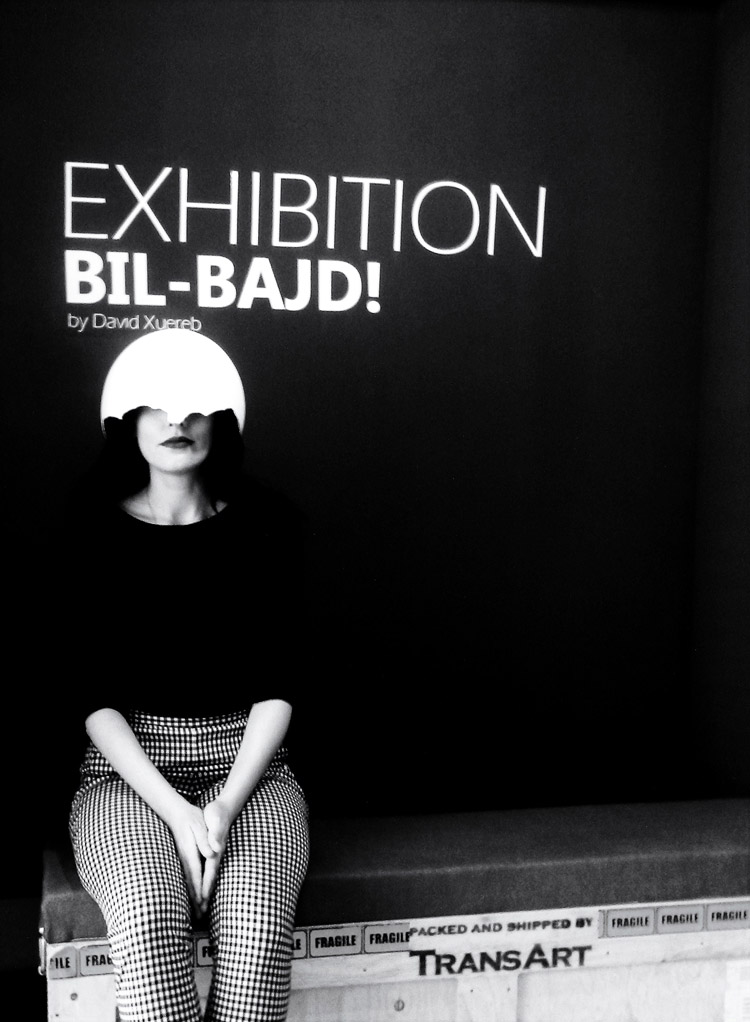
David Xuereb’s Exhibition bil-Bajd!
The first time I met Maltese artist David Xuereb, was during the end of May 2017, at his Last Touch gallery-studio in Mosta. At the time David was running his latest art show: Exhibition bil-Bajd! I had become aware of David’s show through an ad which had cropped up on my facebook feed. Intrigued by its humorous title, and curious to find out what the exhibition was all about, I contacted David who warmly invited me to his gallery-studio for a whizz around. Once there, Xuereb and I discussed the exhibition: his choice of subject, materials, influences and more.
EVE COCKS [EC]: Well, now that I’ve seen your Exhibition bil-Bajd!, I can actually confirm that the subject matter that you’ve chosen for the exhibition is truly about ‘eggs’! All in all the exhibition consists of eight egg sculptures, right? Five of which are created as an everyday food commodity: packed in an egg carton, broken, fried, or soft-boiled in an egg cup – as though ready to be eaten. Whereas the remaining egg pieces are, on the other hand, produced as a luxury objet d’art: standing majestically on intricate gold-plated cabriolet feet, or sitting comfortably as crowns, on royal velvet pillows with gold trimmings and tassels.
DAVID XUEREB [DX]: Correct.
EC: My first thought upon entering the exhibition space was: “Why Eggs?”…”What triggered your interest in organising an exhibition solely about Eggs?”

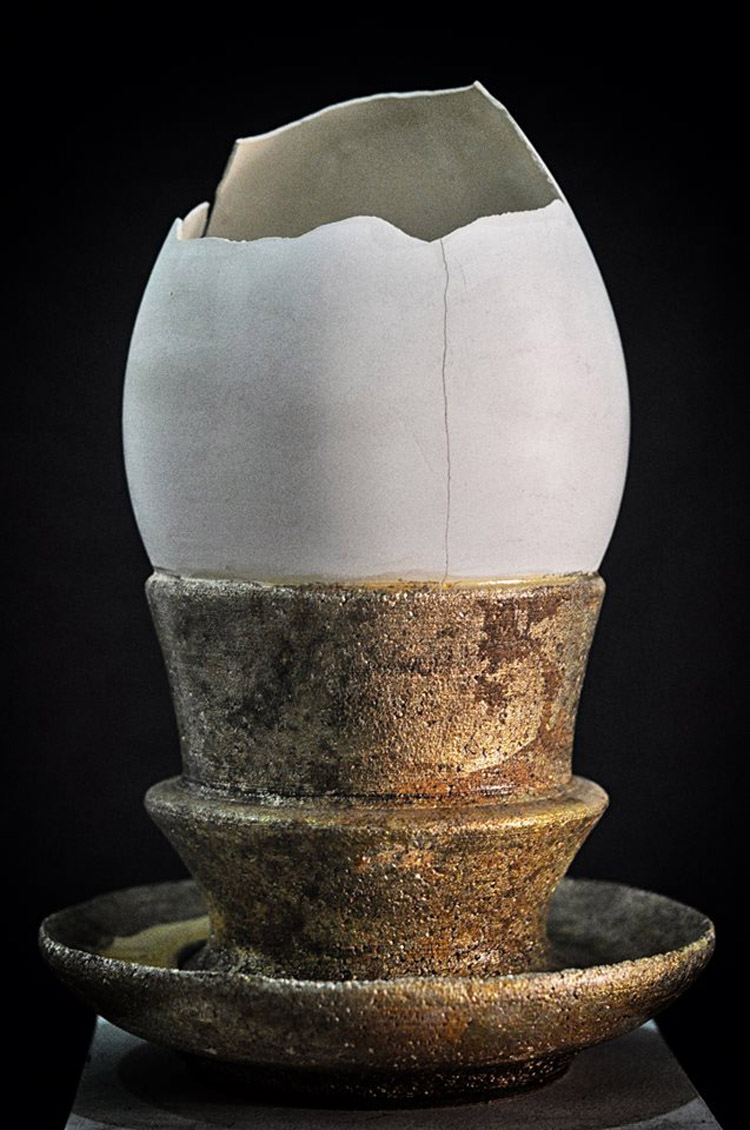
Above: Nofs Tużżana Bajd
Below: Ready to Serve
Photo Credit: Isaac Bezzina
DX: The idea just stemmed from another idea I had, or to be more concise, a small task that I was working on about a year ago.
EC: That sounds interesting! Can you expand a bit on this small task you mention?
DX: At the time I was interested in creating a large hollow egg from plaster of paris. To make an egg which is totally solid from the inside, is really…no big deal, but to create an egg shell, a whole egg shell, using the shape of an inflated balloon is rather challenging, as the plaster of paris can easily crack or break during the process. In fact, it was only after numerous failed attempts (I think it was after my sixth attempt) that I successfully managed to create a whole egg shell. And it was basically the accomplishment of such an arduous task that kindled my interest in creating more and more eggs, until I eventually had enough pieces to actually turn them into works of art and hence, organise an exhibition about eggs.
EC: So your interest in creating a series of eggs, purely derived from your accomplishment of creating the ‘ideal’ egg? OR…did something else attract you to the egg motif?
DX: Well, the egg always attracted me because of its rather common qualities, because it is an everyday object which normally one does not take too much notice of.
EC: As we discussed at the start of the interview, your egg series was varied. In addition to the ‘whole egg’ sculptures, it also consisted of ‘broken egg’ sculpture reliefs, which you titled: Whoops…! and Whoops…again! [pictures below]. How, did these pieces come about?
DX: The broken egg pieces were also coincidental. The idea, in fact, derived from the ‘failed attempts’ to create the ideal egg shells. After I had completed most of the works, I was basically left with loads of broken egg-shell material. I thought it was a pity to throw it all away, so I decided to turn these breakages into actual works of art. In real life, eggs can easily slip from our hands, fall and break, no? I thus thought, why not recreate an egg as though it was accidentally broken. I mean…at the end of the day, whether it is cracked, broken, boiled or fried, it is still an egg.
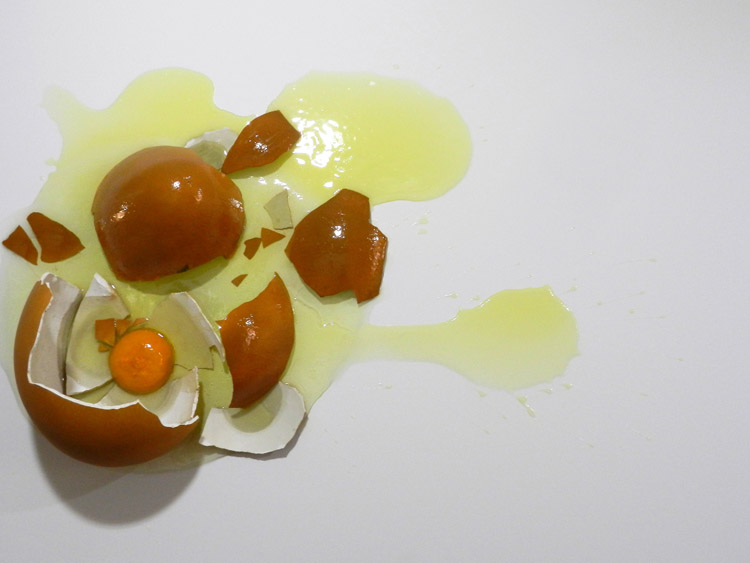
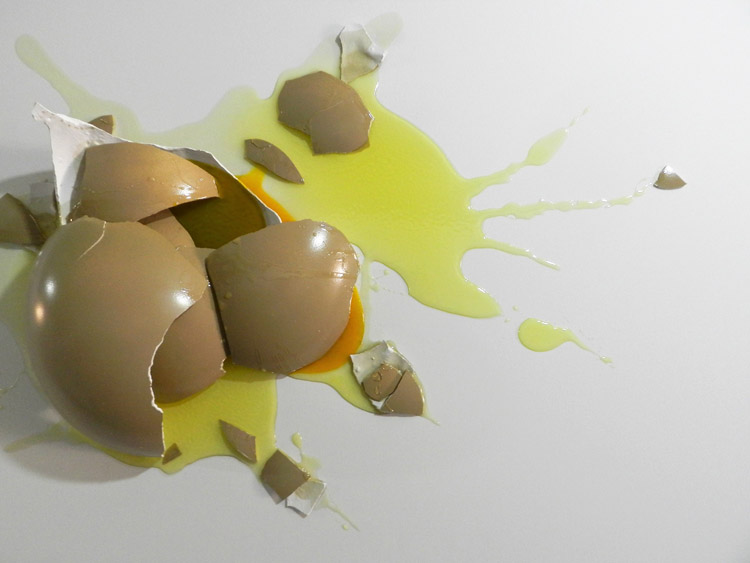
Above: Whoops…!
Below: Whoops…again!
Photo Credit: Eve Cocks
EC: Earlier you said that you used plaster of paris to recreate the egg shells. Are they all made out of such material?
DX: Only the form of the egg shell is made from plaster of paris, as I used other materials to complete the works. Therefore, each work is composed out of mixed-media. As an artist, I like to experiment and try out different techniques and materials.
EC: Did you have any assistants helping out?
DX: Yes I had. Some of the works, such as Nofs Tużżana Bajd , are rather big, so I needed the help of assistants to construct them. Someone who helped me a lot was Isaac Bezzina.
EC: As you probably are already aware, for centuries the egg motif has occupied an important place in the artist’s vocab. Its symbolical potential has intrigued artists to recreate its motif to explore numerous themes concerning man’s creation, death and resurrection. Furthermore, in today’s contemporary art world, the egg motif keeps on being adopted to tackle different issues other than those concerning man’s origin. In fact, if we had to take, for example, Abraham Poincheval’s latest Egg Hatching performance piece, or even, Sarah Lucas’s 1996 photographic Self Portrait with Fried Eggs, both artists incorporated real chicken eggs in their works to speak about gender roles.
Being that artists constantly use the egg motif to speculate about different issues, is there then any particular significance behind your work?
DX: No, not really.
EC: How come?
DX: I wanted to keep them aloof from any allegorical meaning, as I wanted the viewer to come up with his/her own interpretation of what the works might mean.
EC: During a Jeff Koons BBC documentary, the English contemporary artist Damien Hirst had passed on a similar remark: “A lot of people think that artists have to give answers, but [in reality] they don’t [have to]”. Why do you think it is important for an artist ‘not’ to explain his/her works?
DX: I believe that if an artist defines his/her work then…that’s it, no one can say anything different. Leaving the works open to interpretation makes it more interesting for the viewer, really.
EC: Having thus given me the liberty to come up with my own interpretation of your works, here is what I think:
Your egg series represents two type of eggs, or to be more precise, two commercial uses of an egg: ‘the egg’ as a cheap industrialized food commodity (which can be afforded and consumed by many), and ‘the egg’ as an expensive objet d’art (made exclusively to please the capitalist eye). Thus, your egg series reflect the different commercial systems of the modern world. As you are already aware of, the concept of recreating commodities to raise questions about consumer culture is not new to art. Renowned modern and contemporary artists such as Robert Watts, Claes Oldenburg and Jeff Koons, for example, have recreated endless commodities including eggs, to either celebrate or satirize consumerism and capitalism. Since some of your egg pieces do show similarity with the works of these artists, particularly Watts’s Egg Box (c.1963), Oldenburg’s Sculpture in the Form of a Fried Egg (1966/1971), and Koons’s Bowl with Eggs (1994-2009), I was wondering whether you were aware of their egg series before you’ve started working on your own?
DX: Honestly, I’ve never heard about Watts’s and Oldenburg’s egg-works. As regards to Koons, I was/am familiar with his chrome-plated sculptures, however his Bowl with Egg series is also new to me.

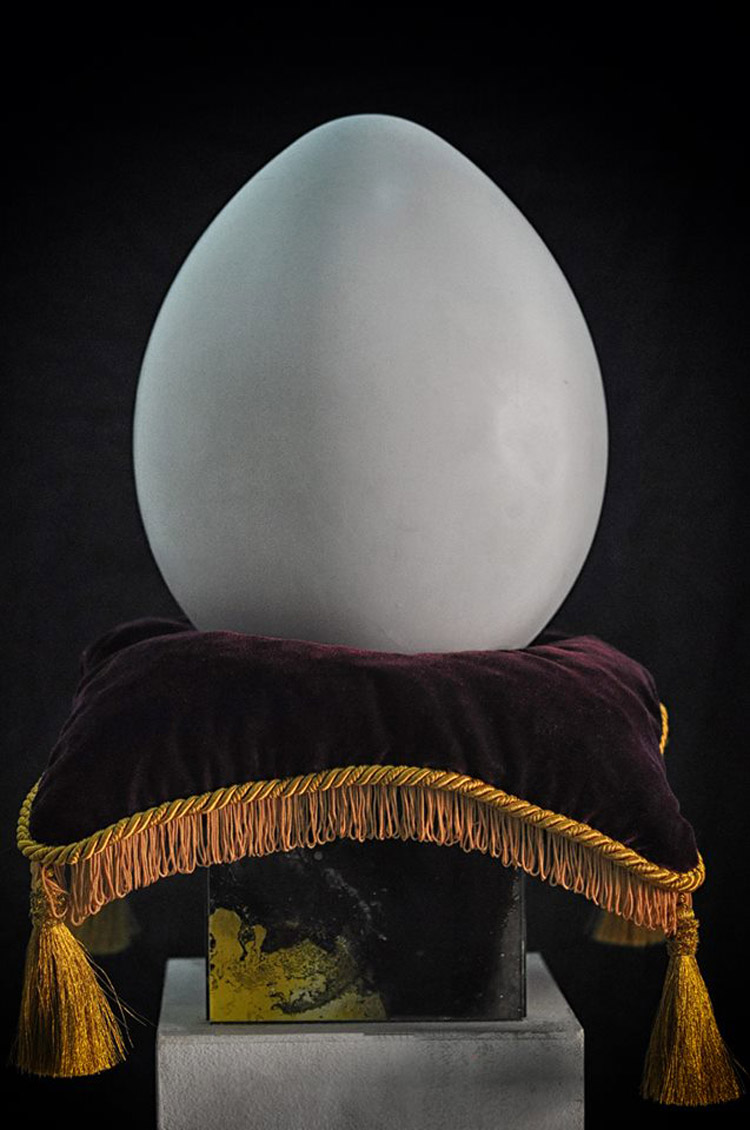
Above: Egg of Fortune
Below: Royal Egg
Photo Credit: Isaac Bezzina
EC: Some of your luxurious-looking egg pieces also echo the Imperial Fabergé eggs.
DX: Yes, in fact the Egg of Fortune is a Fabergé egg, or rather, a cracked Fabergé egg.
EC: The cracked-egg motif once again reminded me of Koons’ works, however, this time, his sleek Cracked Egg series (1994-2006).
DX: I am not familiar with this series either. Earlier I forgot to mention that, before I start working on a project, on any project, I refrain from researching other people’s works; as I know that their ideas would influence me somehow.
EC: My favourites are the Whoops! reliefs and Nofs Tużżana Bajd. I’m intrigued by their realistic tactile qualities. In fact, the egg carton, the crisp sharp edges of the broken egg shell, the firm egg yolk, the viscous egg white… so look like the actual thing, that at one point I was really tempted to touch them.
DX I am glad to hear that, as there is nothing more rewarding than to see people appreciating and interacting with my work.
EC: Talking about interaction, something which I haven’t mentioned yet is that, the exhibition also consists of an interactive egg installation, where viewers are invited to take a selfie with real eggs or a re-created egg shell [pictures below]. This concept reminded me of Erwin Wurm’s One Minute Sculptures. In these performative sculptures, the contemporary Austrian artist instructs the viewer (through drawings or written directions) to become an artwork for the duration of sixty seconds. My question is, was your idea behind the ‘egg-selfie’ similarly to transform the visitor into an artwork?
DX: He he…no, not really. I just wanted to add a touch of fun and humour to the exhibition that’s all.
EC: Since you’ve now mentioned the word humour, I would like to ask you a question about the humorous, attention-grabbing name of the exhibition. Did you title the exhibition Exhibition bil-Bajd! because of its double connotation?
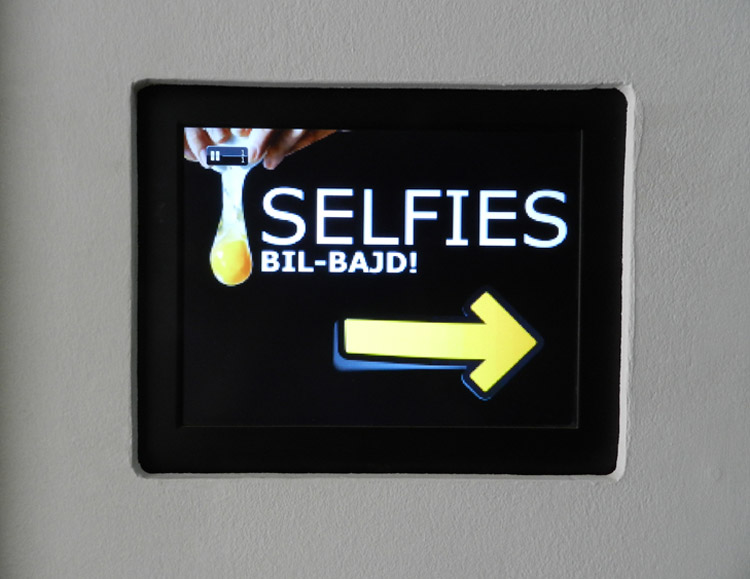
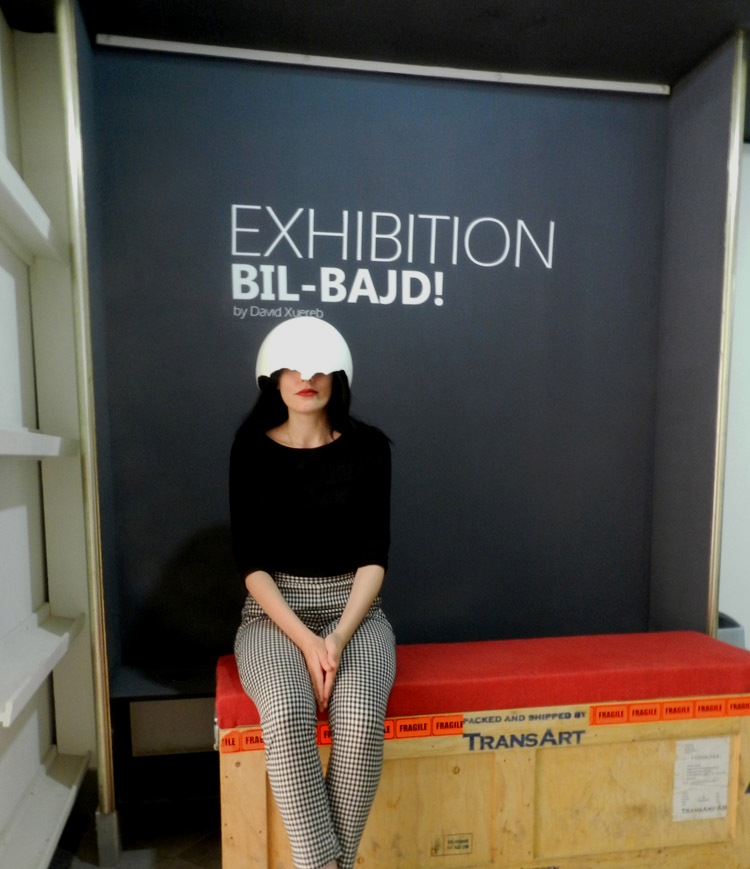
Egg-selfie Installation
Photo Credit: Eve Cocks
DX: My intention was to create an exhibition solely about eggs, so the title simply explains what the exhibition is about: an Exhibition bil-Bajd!…an Exhibition with Eggs. However, being Maltese, it did occur to me that the Maltese-speaking viewer would interpret it differently.
EC: As I did? 🙂
DX: Yes, as you did! 🙂
EC: David, I really enjoyed your exhibition. It was thought-provoking, engaging and fun: a true experience!
DX: Thank you.
EC: I would like to close off this discussion by asking you the following two questions. Since I will be publishing this interview after the close of the exhibition, I was wondering whether the reader would still be able to view some of your egg pieces?
DX: If someone would be interested in viewing my work, all they need to do is contact me, they can find my contact details on my website http://gallerylasttouch.com.mt/ Nonetheless, I would like to point out that some of the pieces have already been sold to private collectors, so they will not be able to view the whole collection.
EC: And have you already thought about your next project?
DX: Most probably, my next exhibition would be on ‘Rooftopography’. It’s a project that I’ve been working on for about two years now. It’s quite a laborious project, so it would take another few years to complete…Issa Naraw! 🙂
EC: Well, I for one, am very much looking forward to your upcoming project! Considering the good job you’ve done with the egg exhibition, I’m pretty sure that, it will be another “exhibition bil-bajd!” 🙂

Artists Vency Maxsim (Left) and David Xuereb (Right)
Photo Credit: Isaac Bezzina
